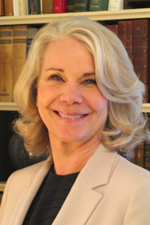UMTC Featured Researcher for August: Dr. Anne Lusk
Anne Lusk, PhD, of the Harvard T.H. Chan School of Public Health, Department of Nutrition, is the UMass Transportation Center’s Featured Researcher for August 2020. Lusk’s career, first as a practitioner and then a researcher, has focused on bicycle facilities and biking environments, and she often partners with colleagues in public health, transportation, and related fields. Her research has emphasized creating comfortable and safe environments to motivate women, children, seniors, families, ethnic minorities, and people with lower incomes, and from around the world, to bicycle.
Lusk’s years as a practitioner started when she was hired by the Town of Stowe, VT in 1982. The Town asked to determine if a bike path was feasible; she built the path instead. The completed tree-framed 5.3 mile path won a number of awards, including designation as a National Recreation Trail, and as the 119th Point of Light in 1989. In 1992, Lusk was the one of the organizers for the 1000-mile East Coast Greenway’s exploratory ride from Boston to Washington, DC. From 1994 to 1997, Anne Lusk served on the Vermont Urban and Community Forestry Council and the Vermont Agency of Transportation’s Bicycle and Pedestrian Advisory Committee.
Lusk began her Ph.D. in Architecture at the University of Michigan, studying bike paths, aesthetics, and destinations, in 1997. While there, she received funding to study bus and bus stop designs related to perceptions of crime and worked in four cities, including inner city Detroit. In 2003, she started as a Visiting Scientist at the Harvard Chan School of Public Health. She and a colleague wrote a report (2004) suggesting that a two-way cycle track/sidepath be installed on Massachusetts Avenue, even though cycle tracks were discouraged by the American Association of State Highway and Transportation Officials (AASHTO) bike guidelines. She and colleagues later published a study (2011) showing that cycle tracks in Montreal had a 28% lower injury rate and 2.5 times as many bicyclists compared with comparable parallel roads. With that paper and a subsequent one, she and colleagues demonstrated that rigorous research was not cited in the AASHTO guidelines to support rejection of cycle tracks. Their research helped change the perception of cycle tracks in federal guidelines. More recently, she and colleagues have published studies that demonstrated the preferences of lower-income ethnic-minority populations for cycle tracks, including because cycle tracks are viewed as being safer in terms of crime and traffic. Their research has also shown that pedestrians and bicyclists prefer having trees between the cycle track and the street. Lusk’s current projects includes publishing her study on seniors’ perceptions of Dutch Van Raam bikes that have been adapted for older riders. She is also interested in researching having tree crews plant and maintain trees by cycle tracks and sidewalks in lower-income ethic minority neighborhoods to reduce heat island effects where developed urban areas retain heat more than rural areas as a result of human activities. Lusk presented on this topic at a recent Baystate Roads Stump the Instructor session on Street Trees and Tree Routes.
From practitioner to academic, Lusk’s years of effort have paid off as cycle tracks serve COVID, equity, and climate change. She has hope for the addition of trees and cycle tracks as aesthetic, healthy, and climate-responsive additions to streets in all neighborhoods.

